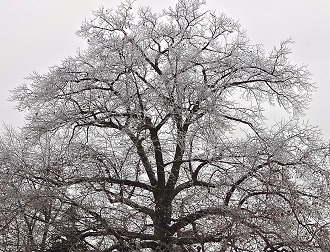
Donors still have the opportunity to get behind this initiative. Any donations received before December 12th, 2020 will be applied to the purchase costs. As of December 12th, 2020, any donations received will support enhancements to the parkette, helping to create a setting befitting of this magnificent tree.



The red oak throughout the seasons. Courtesy of Edith George.
Due to its size, age, beauty and cultural significance, this magnificent 250-year-old oak is recognized as a heritage tree under Forests Ontario’s Heritage Tree Program.
Following Council’s direction and in conjunction with generous support from donors, the funds have been secured to purchase the property and establish the space as a parkette, to preserve and showcase this beautiful living example of our natural heritage.
Watch this short video to learn more about the historic Red Oak’s story.
In September, 2019, Heritage Toronto unveiled a commemorative plaque, which captures this great oak’s place in our natural heritage as follows:
The large red oak (Quercus rubra) situated in the backyard of 76 Coral Gable Drive is more than 250 years old, making it one of the oldest in the city. Before Europeans colonized this area, the Humber River branch of the Toronto Carrying Place trail system passed nearby. The tree was part of its delicate savannah ecosystem. This network of trails and portages was used by Indigenous peoples to travel between Lake Simcoe and Lake Ontario and to trade throughout what is now Southern Ontario and beyond. The tree survived European settlement despite logging along the Humber River, clearance of the land for agriculture, and the development of this suburban neighbourhood in the early 1960s. The Coral Gable Drive red oak is a remarkable specimen of its species and in 2009, Forests Ontario recognized it as a heritage tree.
The ecological, social and economic benefits inherent to preserving and fostering canopy cover are many, including reducing fine particulate matter air pollution, cooling the air by shading surfaces and releasing water vapor, providing habitat for wildlife, reducing storm-water runoff, sequestering carbon from the atmosphere and providing a link to the natural history of the area. In 2020, it was calculated that this oak stores 2.5 tons of carbon dioxide per year (courtesy of Association for Canadian Education Resources)! Now in its full maturity, this red oak’s branches span 24 metres with a trunk circumference of over 5 metres – a natural cathedral and a shining example of our urban forest.
Upon completing the purchase, the vision is to convert the property into a parkette with the oak tree as its primary feature. Details about next steps for the parkette will be added to this site over the next few months. The City will do a formal landscape plan for the parkette but the inspirational rendering below illustrates what the space might look like. Donors from across the city, province and beyond have helped ensure the property is secured and will help create a new home for Toronto’s tree.
